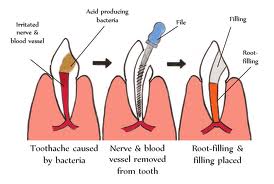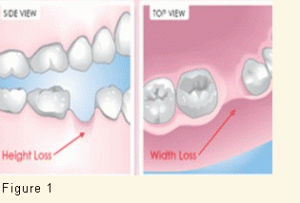When there is a cavity in a tooth, you can have it filled; but what happens if caries has spread deep into your tooth, such that your tooth is infected beyond salvage point? There are several options that you may go for:
-
Root canal treatment or endodontic treatment, retaining the tooth in the mouth
This is a procedure in which, following infiltration of anesthetics, the infected pulp is removed and the root canal sterilized. After that, the root canal is filled with a root canal filling material (gutta perca) that seals off any pathway by which micro-organisms from the mouth may gain entrance into the root canal.
2. Extract the tooth and replace the missing tooth with a false tooth using one of these prosthesis below:
(i)Â Â Â Â Â Â Â Â Â Â Â Â Â Â Â Â Â Dentures
Dentures are divided into partial (when only several teeth are to be replaced) and complete dentures (when all teeth are to be replaced).
(ii)Â Â Â Â Â Â Â Â Â Â Â Â Â Â Â Bridges
Bridges can be
- Â Conventional (Support is taken from adjacent tooth or teeth by crowning it/them) or adhesive (support is derived from adjacent tooth or teeth by adhesion onto some of its/their surface);
- Â Fixed-fixed (the tooth on each side of the missing tooth, meaning, 2 teeth are used as support) or cantilever (only one of the tooth adjacent to missing tooth is used as support).
(iii)Â Â Â Â Â Â Â Â Â Â Â Â Â Â Implants
Reasons in favor of root canal treatment/endodontics:
1. High success rate
Root canal treatment has a very high success if done properly, i.e. 95%. Also, natural tooth which is maintained in the oral cavity can last as long as a vital tooth.
2. Prevents ridge resorption
Retaining a natural tooth also retains the bone and tissues around the tooth that serves to support the tooth. If the tooth is extracted, those supporting tissues will undergo a physiological loss of height and width, a phenomenon called “ridge resorptionâ€. This process has variable rates in different individuals, and may continue over years. If a denture had been fabricated to replace this extracted tooth, ridge resorption will eventually lead to an empty space between the denture and the lowered bone level, resulting in loosening of the denture, which then has to be relined or replaced.
3. Dentures and maintaining oral hygiene
Caring for a root-treated tooth is just the same as you would any natural tooth in your mouth. However, having a denture means you’ll have to maintain cleanliness of both your dentures and natural teeth. You have to remove your denture every night and brush it after every meal. On top of that, if you’ve never had a denture in your life, you might find difficulty in adapting to dentures, for it is like inserting something bulky into your mouth for a long period of time. There is also increased wear and tear to the surrounding tissues that support or provide retention for the denture. Furthermore, dentures are not as comfortable as your own teeth, nor does it provide the same amount of biting force as natural teeth.
 4. Avoids damage to adjacent teeth
Bridges require permanent removal of tooth substances, which is an unnecessary waste as compared to retaining the tooth by root canal therapy. Cleaning can be tedious; you may need a customized floss to clean the areas between each tooth. Poor maintenance of the bridge can lead to caries and periodontal disease in the adjacent supporting natural teeth. Hence, the health of the initially symptomless supporting teeth is compromised.
 5. Aesthetics
Appearance wise, it is harder to try to duplicate the appearance of a tooth, as opposed to keeping the natural tooth itself intact. Although endodontically-treated tooth can turn a shade of black over time due to the gutta perca, this can be fixed using internal bleaching, veneers or crowns.
 6. The conservative option
Root canal treatment is recommended for the simple logic that, should this treatment fail, you can always extract it and look into other options of replacing it.
Reasons in favor of false teeth/prosthetics:
1. Root treatment failure
In cases whereby root canal treatment has failed 2 or more times, it is better to extract it, re-treatment with root canal therapy has a reduced success rate of 70%.
 2. Economical
If there are multiple teeth that are in bad condition or need root treatment, it may be a cheaper option to have them extracted and replaced using a denture, especially in rural areas.
 3. Implants
Implants are ideal for replacing one missing tooth without compromising the health of the adjacent teeth, albeit being more expensive than the other alternatives. It involves a lengthy procedure, as several months of healing following placement of implant are required before the final prosthesis can be fixed. Nevertheless, because they are integrated into the jaw bones, they are able to maintain ridge height and width and almost the same amount of chewing force.



